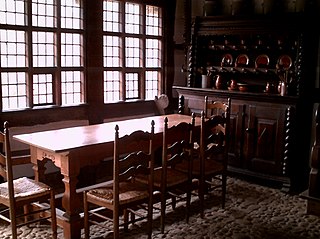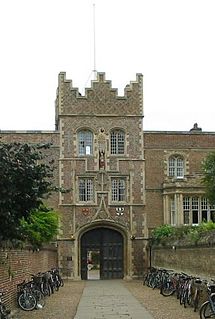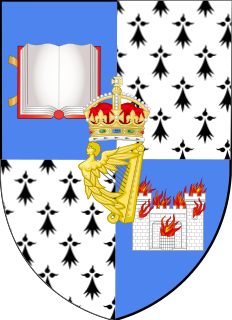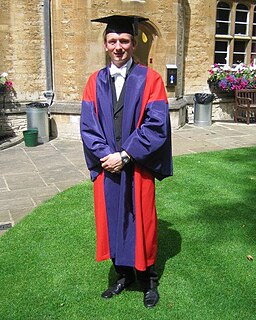
Pembroke College is a constituent college of the University of Cambridge, England. The college is the third-oldest college of the university and has over seven hundred students and fellows. Physically, it is one of the university's larger colleges, with buildings from almost every century since its founding, as well as extensive gardens. Its members are termed "Valencians".

Trinity College is a constituent college of the University of Cambridge in England. With around 600 undergraduates, 300 graduates, and over 180 fellows, it is the largest college in either of the Oxbridge universities by number of undergraduates. In terms of total student numbers, it is second only to Homerton College, Cambridge.

Christ's College is a constituent college of the University of Cambridge. The college includes the Master, the Fellows of the College, and about 450 undergraduate and 170 graduate students. The college was founded by William Byngham in 1437 as God's House. In 1505, the college was granted a new royal charter, was given a substantial endowment by Lady Margaret Beaufort, and changed its name to Christ's College, becoming the twelfth of the Cambridge colleges to be founded in its current form. The college is renowned for educating some of Cambridge's most famous alumni, including Charles Darwin and John Milton.

Peterhouse is a constituent college of the University of Cambridge. It is the oldest college of the university, having been founded in 1284 by Hugo de Balsham, Bishop of Ely, and granted its charter by King Edward I. Today, Peterhouse has 254 undergraduates, 116 full-time graduate students and 54 fellows. The official name of Peterhouse does not include "college", although "Peterhouse College" is often seen in public.

In architecture, a hall is a relatively large space enclosed by a roof and walls. In the Iron Age and early Middle Ages in northern Europe, a mead hall was where a lord and his retainers ate and also slept. Later in the Middle Ages, the great hall was the largest room in castles and large houses, and where the servants usually slept. As more complex house plans developed, the hall remained a large room for dancing and large feasts, often still with servants sleeping there. It was usually immediately inside the main door. In modern British houses, an entrance hall next to the front door remains an indispensable feature, even if it is essentially merely a corridor.

St Edmund Hall is a constituent college of the University of Oxford in England. The college has a claim to be "the oldest academical society for the education of undergraduates in any university" and is the last surviving medieval hall at the University.

Selwyn College, Cambridge is a constituent college of the University of Cambridge in the United Kingdom. The college was founded by the Selwyn Memorial Committee in memory of George Augustus Selwyn (1809–1878), the first Bishop of New Zealand (1841–1868), and subsequently Bishop of Lichfield (1868–1878). It consists of three main courts built of stone and brick along with several secondary buildings, including adjacent townhouses and lodges serving as student hostels on Grange Road, West Road and Sidgwick Avenue. The college has some 60 Fellows and 110 non-academic staff.

St Edmund's College is a constituent college of the University of Cambridge in England. It is the second-oldest of the four Cambridge colleges oriented to mature students, which only accept students reading for either masters or doctorate degrees, or undergraduate degrees if they are aged 21 or older.

Clare Hall is a constituent college of the University of Cambridge, England. Founded in 1966 by Clare College, Clare Hall is a college for advanced study, admitting only postgraduate students alongside postdoctoral researchers and fellows. It was established to serve as an Institute of Advanced Studies and has slowly grown and developed into a full constituent college.

A dining room is a room for consuming food. In modern times it is usually adjacent to the kitchen for convenience in serving, although in medieval times it was often on an entirely different floor level. Historically the dining room is furnished with a rather large dining table and a number of dining chairs; the most common shape is generally rectangular with two armed end chairs and an even number of un-armed side chairs along the long sides.

Van Mildert College is a college of Durham University in England. Founded in 1965, it takes its name from William Van Mildert, Prince-Bishop of Durham from 1826 to 1836 and a leading figure in the University's 1832 foundation. Originally an all-male college, it became the first Durham college to become co-educational in 1972 with the admission of female undergraduates.

Tableware are the dishes or dishware used for setting a table, serving food and dining. It includes cutlery, glassware, serving dishes and other useful items for practical as well as decorative purposes. The quality, nature, variety and number of objects varies according to culture, religion, number of diners, cuisine and occasion. For example, Middle Eastern, Indian or Polynesian food culture and cuisine sometimes limits tableware to serving dishes, using bread or leaves as individual plates. Special occasions are usually reflected in higher quality tableware.

A great hall is the main room of a royal palace, nobleman's castle or a large manor house or hall house in the Middle Ages, and continued to be built in the country houses of the 16th and early 17th centuries, although by then the family used the great chamber for eating and relaxing. At that time the word "great" simply meant big, and had not acquired its modern connotations of excellence. In the medieval period the room would simply have been referred to as the "hall", unless the building also had a secondary hall, but the term "great hall" has been predominant for surviving rooms of this type for several centuries, to distinguish them from the different type of hall found in post-medieval houses. Great halls were found especially in France, England and Scotland, but similar rooms were also found in some other European countries.

Newman College is a Roman Catholic co-educational residential college affiliated with the University of Melbourne. During the university year it houses about 200 undergraduate students and about 80 postgraduate students and tutors. The college was named after Cardinal John Henry Newman, a former Anglican and major figure in the Oxford Movement who became a Roman Catholic in the 19th century. The college continues to commemorate the life of Newman through events such as the "Cardinal Newman Dinner" and the prominent positioning of his portrait in the dining hall. Although most strongly affiliated with the University of Melbourne, a small number of undergraduate students attend RMIT University, or Monash University Faculty of Pharmacy and Pharmaceutical Sciences located on Royal Parade. The College previously accepted a small number of students from the Australian Catholic University.

International Hall is a Hall of Residence owned by the University of London and situated on Brunswick Square and Lansdowne Terrace in the Bloomsbury district of London. It is an intercollegiate hall, and as such provides accommodation for full-time students at institutions such as University College, King's College, Queen Mary, School of Oriental and African Studies, the London School of Economics, and other such constituent colleges of the University of London. It is the largest single hall of the University of London.

In some universities in the United Kingdom and Ireland — particularly collegiate universities such as Oxford and Cambridge, as well as King's College London, Dublin University, Durham University, University of York, University of Kent and Lancaster University — students and the academic body are organised into a common room, or at Cambridge a combination room. This terminology has, in addition, been taken up in some universities in other English speaking nations. The terms JCR, MCR, and SCR are used by Harvard University, Yale University, Princeton University, and the University of Toronto.
Formal Hall or Formal Meal is a meal held at some of the oldest universities in the United Kingdom and the Republic of Ireland at which students usually dress in formal attire and often gowns to dine. These are held commonly in the colleges and halls of Oxford, Cambridge, Dublin, Durham, St Andrews, Bristol, London, the Australian sandstone universities, and Toronto.

Quincy House is one of twelve undergraduate residential Houses at Harvard University, located on Plympton Street between Harvard Yard and the Charles River. The second largest of the twelve undergraduate houses, Quincy House was named after Josiah Quincy III (1772–1864), president of Harvard from 1829 to 1845. Quincy House's official counterpart at Yale University is Branford College.

Jesus College is a constituent college of the University of Cambridge, England. The college's full name is The College of the Blessed Virgin Mary, Saint John the Evangelist and the glorious Virgin Saint Radegund, near Cambridge. Its common name comes from the name of its chapel, Jesus Chapel.


























